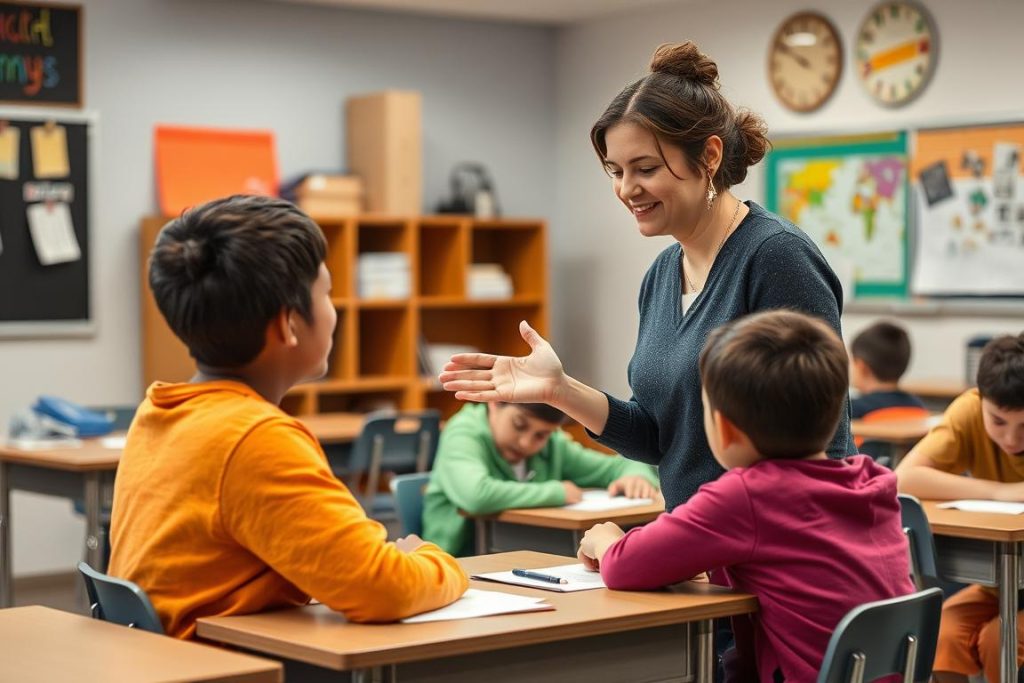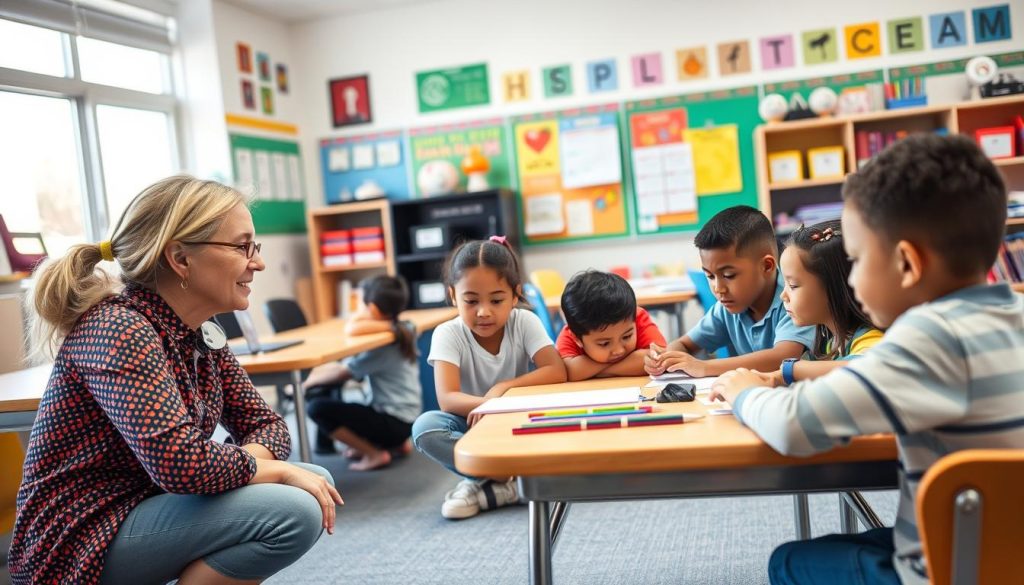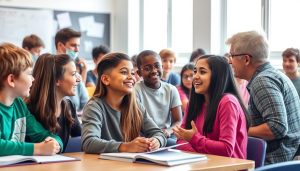The Limitation of the “Practice” Checklist
Many new teachers enter the profession armed with techniques they learned during their training: establish clear rules, use positive reinforcement, implement consistent consequences. While these practices are valuable, they often fall short when applied mechanically without the underlying teacher skills needed to adapt them to specific classroom contexts.
Research from the educational community shows that the most effective teachers don’t simply follow prescribed methods — they understand why certain approaches work and how to modify them based on their students’ unique needs. This adaptability comes from developing core teacher skills that transcend any single discipline strategy.
Consider this scenario: Two teachers implement the same “think-time” strategy for classroom disruptions. One teacher sees minimal improvement, while the other transforms their classroom culture. The difference isn’t in the technique itself but in how the teacher’s relationship-building skills, emotional intelligence, and philosophical approach frame the implementation.
“The most powerful classroom management tool is not a specific technique, but a teacher who understands the emotional and developmental needs driving student behavior.”
— Dr. Thomas Gordon, Educator and Author
The Heart of the Matter: Teacher Skills and Philosophy
Effective classroom management emerges from a foundation of well-developed teacher skills that include emotional intelligence, communication abilities, and a deep understanding of child development. These skills allow educators to see beyond disruptive behaviors to the unmet needs they often represent.
When teachers develop these foundational skills, they’re able to:
- Recognize when behavior issues stem from academic frustration versus emotional challenges
- Adapt communication styles to match students’ developmental stages
- De-escalate tense situations before they become major disruptions
- Build authentic relationships that motivate cooperation
- Create classroom environments where students feel psychologically safe
These teacher skills aren’t innate talents but learned capabilities that improve with intentional practice and reflection. Professional development opportunities that focus on these foundational skills often yield more significant classroom improvements than those teaching isolated management techniques.

Good Effective Discipline as a Core Framework
Good Effective Discipline represents a shift from reactive punishment to proactive teaching. Rather than focusing on controlling student behavior through consequences, this approach emphasizes teaching students the skills they need to regulate their emotions and make responsible choices.
The core principles of Good Effective Discipline include:
Mutual Respect
Students are treated with the same respect we expect from them, modeling the behavior we wish to see.
Clear Boundaries
Expectations are communicated clearly and consistently, with logical consequences that help students learn from mistakes.
Skill Building
Discipline moments become opportunities to teach self-regulation, problem-solving, and communication skills.
Relationship Focus
Strong teacher-student connections form the foundation for cooperation and motivation.
This framework requires teachers to develop specific skills that go beyond traditional classroom management techniques. These teacher skills include emotional regulation, effective communication, and the ability to identify the needs underlying challenging behaviors.
Enhance Your Classroom Management Skills
Discover practical strategies for implementing Good Effective Discipline in your classroom with our comprehensive resource guide.
Implementing Good Effective Discipline Through Relationship Building
At the heart of Good Effective Discipline is the understanding that strong teacher-student relationships are prerequisites for effective classroom management. When students feel connected to their teachers, they’re more motivated to meet expectations and less likely to engage in disruptive behaviors.

Building these connections requires specific teacher skills that can be developed through practice:
Active Listening
When teachers truly listen to students—making eye contact, reflecting back what they hear, and asking thoughtful questions—they communicate that students’ thoughts and feelings matter. This simple practice builds trust and helps teachers understand the root causes of behavior issues.
Positive Attention
Noticing and acknowledging positive behaviors is more effective than focusing on rule violations. Teachers skilled in Good Effective Discipline maintain a ratio of at least 3:1 positive to corrective interactions, which research shows significantly improves classroom climate.
Morning Meetings
Starting the day with a structured community-building activity creates a sense of belonging and sets a positive tone. These meetings develop students’ social-emotional skills while strengthening teacher-student connections.
According to a study published in the Journal of Education, students who report strong relationships with their teachers are 31% more likely to engage in classroom activities and 23% less likely to exhibit disruptive behaviors.
Teacher Reflection: How much time do you intentionally dedicate to relationship-building each day? Consider setting aside 5-10 minutes daily for connection activities that don’t involve academic content.
The Role of Communication in Good Effective Discipline
Effective communication is perhaps the most essential teacher skill within the Good Effective Discipline framework. How teachers speak to students—their tone, word choice, and body language—can either escalate or de-escalate challenging situations.
Language That Empowers
- “When you finish your math problems, then you can choose a center activity.”
- “I notice you’re having trouble focusing. What would help you right now?”
- “In our classroom, we speak respectfully to classmates.”
Language That Diminishes
- “If you don’t finish your math, you’ll lose recess.”
- “Why can’t you just pay attention like everyone else?”
- “Stop being so rude to your classmates.”
The first set of examples demonstrates communication skills that maintain student dignity while clearly communicating expectations. These approaches are central to Good Effective Discipline because they teach rather than shame.
Non-Verbal Communication
Teacher skills also include mastery of non-verbal cues that can prevent minor disruptions from escalating:
- Proximity – Moving closer to a distracted student without interrupting instruction
- Eye contact – A quick glance that communicates awareness
- Hand signals – Quiet reminders of classroom expectations
- Facial expressions – Conveying encouragement or redirection

Developing these communication skills takes practice and reflection. Many teachers find that recording and reviewing their classroom interactions helps them identify patterns in their communication style that they can refine to better support Good Effective Discipline.
Consistency and Flexibility: The Balancing Act of Good Effective Discipline
One of the most challenging aspects of implementing Good Effective Discipline is finding the right balance between consistency and flexibility. Students need predictable boundaries to feel secure, but rigid enforcement of rules without consideration for context can damage relationships and miss valuable teaching opportunities.
Effective teachers develop the skill of “flexible consistency” — maintaining clear expectations while adapting their responses to individual students’ needs and circumstances. This requires:
Understanding the “Why” Behind Behavior
When teachers develop the skill of looking beyond the behavior to identify its cause, they can respond more effectively. A student who disrupts class because they don’t understand the material needs a different response than one seeking peer attention.
Differentiating Responses
Good Effective Discipline recognizes that students have different needs and are at different developmental stages. A one-size-fits-all approach to discipline rarely works. Teachers skilled in differentiation adjust their expectations and supports while maintaining high standards for all.
Teaching Self-Regulation
The ultimate goal of Good Effective Discipline is to help students develop internal control rather than relying on external management. This requires teachers to gradually release responsibility as students develop the skills to manage their own behavior.
How can I be consistent while still responding to individual needs?
Consistency comes from having clear principles that guide your responses, not from treating every situation identically. For example, you might have the principle that “all students need a chance to calm down before problem-solving.” How this looks might differ—one student might need a quiet corner, while another benefits from a brief walk with a teacher.
Developing these teacher skills requires ongoing reflection and adjustment. Many educators find that professional learning communities focused on Good Effective Discipline provide valuable support for this challenging work.
Practical Strategies for Implementing Good Effective Discipline
Moving from theory to practice requires specific strategies that teachers can implement immediately. Here are evidence-based approaches that align with the principles of Good Effective Discipline:
Proactive Approaches
- Create clear, positively-stated expectations with student input
- Teach procedures explicitly and practice regularly
- Design engaging lessons that minimize downtime
- Arrange classroom space to support desired behaviors
Responsive Strategies
- Use private corrections rather than public reprimands
- Implement logical consequences connected to the behavior
- Provide choices within limits to maintain student dignity
- Create opportunities for students to repair relationships
Reflective Practices
- Hold brief restorative conversations after incidents
- Teach students to identify emotions and needs
- Model self-reflection and apologize when appropriate
- Document patterns to identify triggers and solutions
These strategies require teachers to develop specific skills, including emotional regulation, clear communication, and problem-solving. As teachers practice these approaches, they become more natural and effective.
One particularly effective tool is the classroom calm-down space—a designated area where students can go to regulate their emotions before rejoining learning activities. Unlike traditional time-out, this space is not punitive but supportive, equipped with tools that help students identify feelings and practice calming strategies.
Ready to Transform Your Classroom Management?
Get access to printable resources, visual supports, and detailed implementation guides for creating a classroom environment based on Good Effective Discipline principles.
Teacher Self-Care: The Foundation of Good Effective Discipline
Implementing Good Effective Discipline requires emotional energy and patience. Teachers who neglect their own well-being often find themselves resorting to reactive discipline approaches during stressful moments. Developing self-care skills is therefore an essential component of effective classroom management.
Emotional Regulation for Teachers
The teacher skills that help students manage their emotions are equally important for educators. Strategies like deep breathing, positive self-talk, and mindfulness help teachers respond thoughtfully rather than reactively to challenging behaviors.
Boundaries and Balance
Sustainable teaching requires clear boundaries between work and personal life. Teachers who model Good Effective Discipline recognize their limits and prioritize activities that restore their energy.
Professional Support Networks
No teacher should implement Good Effective Discipline in isolation. Connecting with colleagues who share similar approaches provides valuable emotional support and practical ideas.
“The most important teacher skill might be the ability to regulate our own emotions in challenging moments. When we stay calm in the face of disruption, we teach more effectively than any lecture could.”
— Elementary Teacher and Mindfulness Coach
Many teachers find that professional development focused on teacher well-being significantly improves their ability to implement Good Effective Discipline consistently and effectively.
Measuring the Success of Good Effective Discipline
How do we know if our approach to Good Effective Discipline is working? While reduced disruptions are one indicator, truly effective discipline has much broader impacts on classroom culture and student development.
Short-Term Indicators
- Decreased office referrals
- Increased learning time
- More positive classroom interactions
- Improved student engagement
Medium-Term Outcomes
- Students using conflict resolution skills
- Increased student self-advocacy
- More collaborative classroom culture
- Improved academic performance
Long-Term Impact
- Students demonstrating empathy
- Self-directed learning behaviors
- Reduced achievement gaps
- Stronger school community
Effective teachers regularly collect data on these indicators to refine their approach. This might include tracking the frequency of specific behaviors, gathering student feedback, or documenting examples of positive student interactions.

The most meaningful measure of Good Effective Discipline’s success is how students behave when no one is watching. When students make positive choices because they understand the impact of their actions—not because they fear punishment—we know our teacher skills are making a lasting difference.
Conclusion: Beyond Practices to Principles
Good teaching truly is not just about the right practices—it’s about developing the teacher skills and philosophical approach that allow those practices to be effective. Good Effective Discipline provides a framework that helps teachers move beyond mechanical implementation of techniques to thoughtful, responsive interactions that build students’ capacity for self-regulation and positive decision-making.
By focusing on relationship-building, clear communication, and the balance between consistency and flexibility, teachers create classrooms where students feel respected, capable, and motivated to contribute positively. These environments not only reduce disruptive behaviors but foster the social-emotional skills students need for lifelong success.
As you reflect on your own approach to classroom management, consider how you might shift from a focus on controlling behavior to teaching the skills students need. This journey requires ongoing learning and refinement of your teacher skills, but the impact on your students—and your own professional satisfaction—makes it well worth the effort.
Continue Your Professional Growth
Ready to deepen your understanding of Good Effective Discipline and develop the teacher skills that transform classroom management? Our comprehensive resources provide practical strategies, printable materials, and ongoing support.




